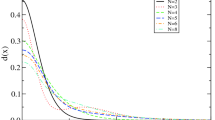Abstract
In this work, we demonstrate the viability of using distributed Gaussian orbitals as a basis set for the calculation of the properties of electrons subjected to an external potential. We validate our method by studying one-electron systems for which we can compare to exact analytical results. We highlight numerical aspects that require particular care when using a distributedGaussian basis set. In particular, we discuss the optimal choice for the distance between two neighboring Gaussian orbitals. Finally, we show how our approach can be applied to many-electron problems.









Similar content being viewed by others
References
Szabo A, Ostlund NS (1989) Modern quantum chemistry: Introduction to advanced structure theory. Dover Publications Inc., Mineola
Boys SF (1950) Proc R Soc London A 200:542
Schlegel H, Frisch M (1990) Int J Quantum Chem 54:83
Diaz-Marquez A, Battaglia S, Bendazzoli GL, Evangelisti S, Leininger T, Berger JA (2018) J Chem Phys 148:124103
Wigner E (1934) On the interaction of electrons in metals. Phys Rev 46:1002. https://doi.org/10.1103/PhysRev.46.1002
Bouet D, Lecoq A, Battaglia S, Evangelisti S, Faginas-Lago N, Leininger T, Lombardi A (2018) Submitted to Mol Phys
Frost AA, Prentice BH III, Rouse RA (1967) J Am Chem Soc 89:3064
Frost AA (1967) J Phys Chem 47:3707
Frost AA (1967) J Phys Chem 47:3714
Frost AA (1968) J Chem Phys 72:1289
Frost AA, Rouse RA (1968) J Am Chem Soc 90:1965
Frost AA (1977). In: HFS III (ed) Methods of electronic structure theory. Springer Science-Business Media, New York
Perlt E, Brüssel M, Kirchner B (2014) Phys Chem Chem Phys 16:6997
Perlt E, Apostolidou C, Eggers M, Kirchner B (2016) Int J Chem 8:194
Gill PMW, Loos PF, Agboola D (2014) J Chem Phys 141:244 102
Salter EA, Trucks GW, Cyphert DS (2001) Am J Phys 69:120
Loos PF, Gill PMW (2012) Phys Rev Lett 108:083002
Messiah A (1966) Quantum mechanics. North-Holland Publishing Company
Loos PF, Ball CJ, Gill PMW (2014) J Chem Phys 140:18A 524
Loos PF, Gill PMW (2010) J Chem Phys 132:234111
Olver FWJ, Lozier DW, Boisvert RF, Clark CW (eds) (2010) NIST handbook of mathematical functions. Cambridge University Press, New York
Loos PF, Gill PM (2012) Harmonically trapped jellium. Mol Phys 110(19-20):2337
Acknowledgments
This work was partly supported by the French “Centre National de la Recherche Scientifique” (CNRS, also under the PICS action 4263). It has received funding from the European Union’s Horizon 2020 research and innovation programme under the Marie Skłodowska-Curie grant agreement no642294. This work was also supported by the “Programme Investissements d’Avenir” under the program ANR-11-IDEX-0002-02, reference ANR-10-LABX-0037-NEXT. The calculations of this work have been partly performed by using the resources of the HPC center CALMIP under the grant 2016-p1048. Finally, one of us (ADM) acknowledges the support of the “Theoretical Chemistry and Computational Modeling(TCCM) Erasmus-Plus Master program.
Author information
Authors and Affiliations
Corresponding author
Additional information
This paper belongs to Topical Collection 11th European Conference on Theoretical and Computational Chemistry (EuCO-TCC 2017)
Appendix: Energy contribution from the transverse components of the Gaussians
Appendix: Energy contribution from the transverse components of the Gaussians
In this appendix, we derive the contribution to the energy due to the transverse components of the 3D Gaussian functions.
The electron wavefunction ψα(r) is expanded as a linear combination of the \(\phi _{i}^{\alpha }\) orbitals:
By inserting Eq. 15 into Eq. 23, we obtain
By acting on ψα(r) with the Hamiltonian, given in Eq. 8, and scalar multiplying the resulting equation by 〈ϕα(r)| one finally gets, after a separation of variables, the three independent equations
The first two equations have the solution Ex = Ey = α/2. This can be easily verified by explicitly performing the second derivative contained in the kinetic energy, and integrating the resulting expression. Alternatively, we note that a one-dimensional Gaussian with exponent α is the ground-state eigenfunction of a harmonic oscillator with eigenvalue α. Because of the virial theorem, the mean value of the kinetic energy is equal to the mean value of the potential energy, and hence equal to one half of the total energy, i.e., Ex = Ey = α/2.
The third equation corresponds to the projection of a true 1D eigen-equation for Hz onto the set of non-orthogonal basis functions \(|\exp (-\alpha (z-Z_{i})^{2})\rangle \). This means that the wavefunction is expressed as the product of three independent functions, depending on x, y, and z, respectively. Since the Hamiltonian is separable, the time-independent Schrödinger equation will have an energy given by the sum of three independent terms. The functions ψα(x) and ψα(y) do not contain any parameter, and their energy contributions will be those of a single Gaussian. The ψα(z) function can be computed, via the variational principle, by minimizing its energy. In the limit \(M \rightarrow \infty \), ψα(z) will be an arbitrary function on the [0,L] interval, vanishing in all points z∉[0,L].
Rights and permissions
About this article
Cite this article
Brooke, L., Diaz-Marquez, A., Evangelisti, S. et al. Distributed Gaussian orbitals for the description of electrons in an external potential. J Mol Model 24, 216 (2018). https://doi.org/10.1007/s00894-018-3749-x
Received:
Accepted:
Published:
DOI: https://doi.org/10.1007/s00894-018-3749-x



